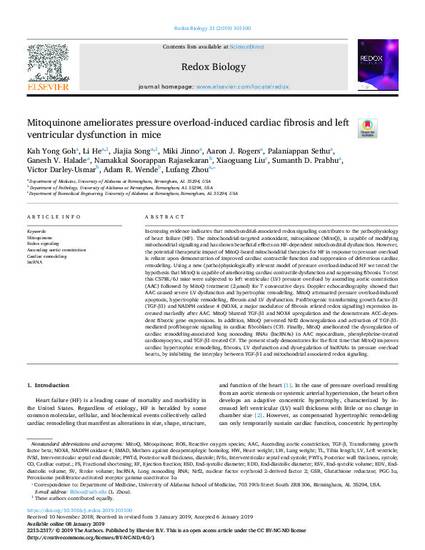
- Ascending aortic constriction,
- Cardiac remodeling,
- IncRNA,
- Mitoquinone,
- Redox signaling
Increasing evidence indicates that mitochondrial-associated redox signaling contributes to the pathophysiology of heart failure (HF). The mitochondrial-targeted antioxidant, mitoquinone (MitoQ), is capable of modifying mitochondrial signaling and has shown beneficial effects on HF-dependent mitochondrial dysfunction. However, the potential therapeutic impact of MitoQ-based mitochondrial therapies for HF in response to pressure overload is reliant upon demonstration of improved cardiac contractile function and suppression of deleterious cardiac remodeling. Using a new (patho)physiologically relevant model of pressure overload-induced HF we tested the hypothesis that MitoQ is capable of ameliorating cardiac contractile dysfunction and suppressing fibrosis. To test this C57BL/6J mice were subjected to left ventricular (LV) pressure overload by ascending aortic constriction (AAC) followed by MitoQ treatment (2 µmol) for 7 consecutive days. Doppler echocardiography showed that AAC caused severe LV dysfunction and hypertrophic remodeling. MitoQ attenuated pressure overload-induced apoptosis, hypertrophic remodeling, fibrosis and LV dysfunction. Profibrogenic transforming growth factor-β1 (TGF-β1) and NADPH oxidase 4 (NOX4, a major modulator of fibrosis related redox signaling) expression increased markedly after AAC. MitoQ blunted TGF-β1 and NOX4 upregulation and the downstream ACC-dependent fibrotic gene expressions. In addition, MitoQ prevented Nrf2 downregulation and activation of TGF-β1-mediated profibrogenic signaling in cardiac fibroblasts (CF). Finally, MitoQ ameliorated the dysregulation of cardiac remodeling-associated long noncoding RNAs (lncRNAs) in AAC myocardium, phenylephrine-treated cardiomyocytes, and TGF-β1-treated CF. The present study demonstrates for the first time that MitoQ improves cardiac hypertrophic remodeling, fibrosis, LV dysfunction and dysregulation of lncRNAs in pressure overload hearts, by inhibiting the interplay between TGF-β1 and mitochondrial associated redox signaling.
Redox Biology, v. 21, art. 101100
Available at: http://works.bepress.com/ganesh-halade/57/